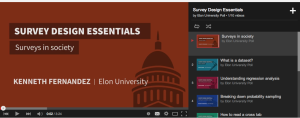Professors Fernandez and Husser use YouTube to explain basics of polling
 Dataset. Regression analysis. Sampling error. If you have had experience with creating and administering surveys, you have probably heard these terms before. But could you define them off the top of your head? That is what Dr. Kenneth Fernandez and Dr. Jason Husser, professors in the political science and director and assistant director of the Elon Poll respectively, noticed: students, faculty and professionals alike asked the same basic questions about surveying.
Dataset. Regression analysis. Sampling error. If you have had experience with creating and administering surveys, you have probably heard these terms before. But could you define them off the top of your head? That is what Dr. Kenneth Fernandez and Dr. Jason Husser, professors in the political science and director and assistant director of the Elon Poll respectively, noticed: students, faculty and professionals alike asked the same basic questions about surveying.
In response, the pair worked with Elon’s Teaching and Learning Technology department to create the Survey Design Essentials series, ten short videos available on YouTube that break down the most-asked questions about surveying.
Why videos?
For their classes, Research Methods for Political Science and Public Opinion Polling, Dr. Husser and Dr. Fernandez realized they were getting the same types of questions about polling. At first, they looked through the internet for videos to help, but quickly realized how low-quality the material out there was.
“Despite YouTube having million of videos, there is a dearth of high quality instructional videos,” Husser said. “We would watch videos [on game theory, for example] and the videos would be so low-quality that I would not expect students to watch. I just want them to have conceptual understanding.”
The pair then met and decided to make these videos with their students in mind. But as soon as they started, the scope of their intended audience grew.
“We originally had internal audiences in mind,” Fernandez said. “But as we started, we realized if we were going through all the trouble, we should cover a bunch of questions. We brainstormed the ten common things that came up over and over again. These are the things we addressed in classes, that students in other classes asked about and journalists and regular citizens were interested in.”
The video series, ten videos about two to three minutes long, focuses on these basics of poling, from how to read a cross tab to the pros and cons of various polling methods. In general, they have found the videos have worked in answering those frequently asked questions.
“I felt they were very useful for their class,” Fernandez said. “For a course that’s completely about research methods, it’s nice to have something that can remind people. We chose these ten frequently-asked questions, so when we’re asked about them, we can send the link Then, they can watch the three minute video, and come back if they have other questions.”
MORE: Elon faculty can easily add Survey Essential Designs playlist to their Moodle course by following these directions.
Criteria for good videos
Through the process of producing these videos, Dr. Fernandez and Dr. Husser realized that the most successful videos shared a few characteristics, like simplicity and longevity.
“We picked up on certain criteria for the videos,” Dr. Husser said. “We had to make sure it was not a time bound subject. It isn’t useful if these videos have a shelf life. We picked topics that a lot of people use, not just people in political science. Sometimes, learning concepts seem scary to people and they shut down. We needed the topics to be fun enough that people watch.”
But more than that, they knew that their words alone weren’t going to get the point across. They emphasize the importance of the graphics and visual aspects of a video that makes a topic interesting and that much more approachable.
“Video has some power that prose does not by itself,” Dr. Husser said. “Graphics drive home what folks are talking about. It is easier to watch a video that read a long description of us. It needs to be just enough of a surface level understanding for people to operate later.”
For the graphics, they credit the staff at the Teaching and Learning Technologies (TLT), who brought their ideas to life and added a depth to their information that spoken word lacked alone.
“The moral of story is TLT is an incredible resource for both students and faculty members,” Dr. Husser said.
Beyond polling
While Dr. Fernandez and Dr. Husser have heard positive feedback with their videos on polling, they don’t think this success is limited to their subject matter. Both believe short, informative videos like these can be easily translated for other topics.
“It’s a good pilot to show other faculty with other topics in mind what they can do,” Fernandez said. “Maybe this would be beneficial maybe for some others not feasible. For example, a pre-law advisor is typically asked the same dozen questions a thousand times by students. He or she could do half a dozen videos that people could watch, so by the time the student sees the pre-law advisor, they’re already up to speed.”
Keeping in their expertise, they point out the upcoming election as another possible topic for videos. From the Iowa caucus to how to use turbo voting, they see a lot of potential for more videos in the election.
Dr. Fernandez and Dr. Husser agree that overall, the experience with creating simple, informational videos they can reference again and again has been a positive one, and they are already brainstorming their next series.
 Follow
Follow

